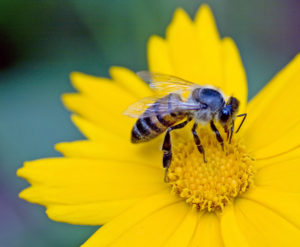
Did you know that 1 out of every 3 bites of the food we eat is a direct result of honeybee pollination? Alarmingly honeybees and bumblebees are in crisis. In the United States, there are over 4,000 species of native bees. Some have shown no evidence of decline, and in highly urbanized areas some are even thriving, yet many other species that are good at pollinating are struggling.
In addition, your flowers and gardens may too be suffering from a lack of effective pollination. What can you do to help? Plant bee-friendly plants in your yard, especially spring-flowering plants! You see early spring is a vulnerable time for bees. Honeybees may have low to no food reserves left in their hive. Honeybees spend the entire winter in a cluster in their hive, trying to keep the queen bee warm in the middle, while rotating positions so as to keep themselves warm too. The worker bees eat the honey that is stored in their hive, which gives them the energy they need to produce body heat by beating their wings.
Queen bumblebees hibernate in holes in the ground, and the rest of her colony dies off in the fall. When she awakens from hibernation in the spring, she too will need extra energy to prepare a nesting site and lay her eggs.
All of this activity by both types of bees requires a tremendous amount of pollen and nectar to grow the next generations of bees. Despite this need, the right flowers are often not available. Many common, early-blooming flowers just do not offer sufficient pollen or nectar. Excellent choices for early spring-flowering plants to include in your garden are star magnolia, lilacs, apple trees and flowering crabs, primrose, lungwort, bleeding heart, peony, Jacob’s ladder and ajuga.
The bees also really enjoy feeding on dandelions and clover, which provide an important early source of food. If you can wait to spray your lawn for these particular weeds until they are almost done blooming, or maybe not even spray them at all if they are in a location that isn’t too bothersome, it is one more way you can help the bees. As always, if you have questions we are happy to help.
Some fascinating facts about bees that you may not know is that in their 6-8 week lifespan a worker bee will fly the equivalent distance of 1.5 times the circumference of the earth! Did you also know that worker honeybees have different jobs depending upon their age?
* At 1-2 days old their job is to clean the cells, starting with the one they were born in.
* 3-5 days old they feed the older larvae
* 6-11 days old they feed the youngest larvae
* 12-17 days old they produce wax, carry food, build combs and have undertaker duties
* 18-21 days old they are on guard duty at the hive entrance
* From 22 days old till the end of their life around 40-45 days they fly around collecting pollen, nectar and water.
Sources: beekeepingbasic.com, fs.fed.us
